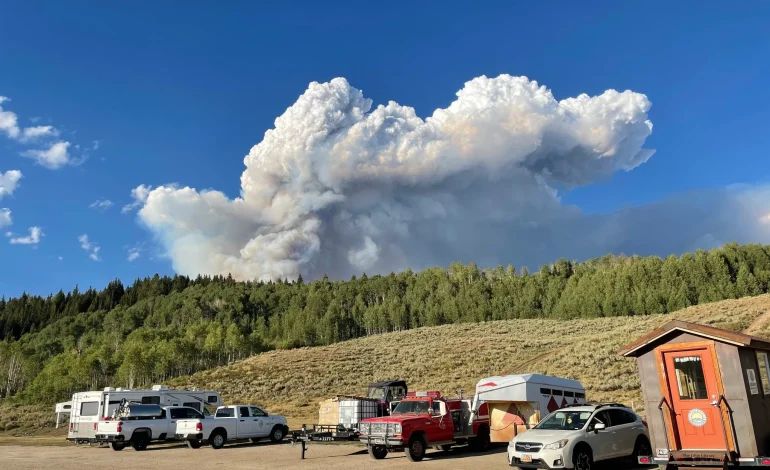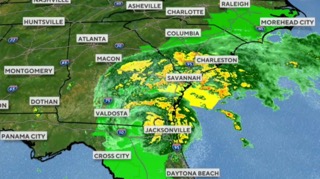‘We Can See the Flames’: Wyoming Wildfires Keep Residents Awake at Night

Cooler temps, higher humidity, and even a bit of rain have rolled into western Wyoming, but the relief has been fleeting. Two wildfires continue to expand, sending smoke, ash, and fear across communities that are now spending sleepless nights watching the ridgelines glow orange.
For locals like Sandy Wright, who owns the Kendall Valley Lodge on the west side of the Green River, the situation feels surreal. On the opposite bank, the Dollar Lake Fire—now burning across 13,449 acres—keeps pushing through heavy timber and thick underbrush.
“We can see the flames on top of the ridge from the lodge here now,” Wright said Tuesday. “It did come over the ridge out toward the river, but it’s still on top.”
Overnight rain offered a small dose of comfort, but it wasn’t enough to silence the constant worry. Instead, residents awoke to wet ash speckling the ground.
“The rain made us feel a lot better, and the ground was damp this morning. It didn’t rain a whole lot, but we got some. We’re supposed to get more,” Wright said.
Even so, the knowledge that flames are burning just across the river keeps her and others on edge.
Despite 0% containment, crews aren’t standing still. The Sierra/Nevada Team 5 incident command says they’ve been busy cutting fire lines, conducting burnout operations, and cleaning up hot spots both along the perimeter and inside the fire’s footprint. Their top priority remains protecting the Red Cliff Bible Camp, which had to be evacuated last week when the fire exploded from a few dozen acres to thousands practically overnight.
The camp and a five-mile radius around Dollar Lake remain under mandatory evacuation. Fire crews are doing everything they can to shield structures with bulldozers, burnouts, and structure defense equipment.
Still, conditions remain treacherous. The forest is overloaded with dead and downed timber, creating a tinderbox that burns with flame lengths over 100 feet. Combined with steep, rocky terrain that keeps vehicles out, firefighters have been forced into a strategy of corralling the fire against natural barriers like cliffs, ridgelines, and meadows, rather than trying to attack it head-on.
Southwest of Dollar Lake, the Willow Creek Fire near Smoot is showing more promising results. After beginning the week with zero containment, crews now report 12% containment, largely on the eastern flank where defensive operations held strong.
Roughly 151 firefighters are on site, reinforcing structures in Smoot and the Allred Flat Campground with sprinkler systems and pump kits. Officials say containment could come as soon as Sept. 5, provided weather cooperates.
But even the rain that’s fallen so far has its limits. Fire managers point out that dense forest canopies act like giant umbrellas, catching precipitation before it reaches the forest floor. That means the dry fuel—pine needles, downed branches, and brush—that feeds these fires often stays dangerously flammable even after a downpour.
Further north in the Bighorn Basin, the state’s largest blaze so far this year—the Red Canyon Fire—is finally calming. The fire has burned 125,000 acres, but with 80% containment now in place, crews are beginning to scale back. Command will soon be handed from a regional incident management team to a smaller local crew to finish mop-up and rehabilitation work.
To date, the financial toll of fighting these fires has been staggering:
- Willow Creek: $900,000
- Dollar Lake: $4.6 million
- Red Canyon: $14.9 million
The fires aren’t just threatening property—they’re reshaping life in western Wyoming. In Pinedale, smoke has blanketed the valley so thickly that the usually commanding Wind River Range is now invisible. Air quality readings have hovered in the “unhealthy” zone for days.
Local photographer Dave Bell, who runs a Facebook page showcasing Wind River landscapes, says he’s watched as visitors cancel hiking trips and trailhead parking lots sit half-empty during what’s normally peak season.
“With smoke like we have in Pinedale today, the air quality is horrible,” Bell said. “Hiking in the mountains, carrying a backpack—it probably wouldn’t be healthy.”
For many residents, it’s not just the smoke but the sight of the flames themselves that keeps them awake. Even with the promise of more rain in the forecast, there’s little peace of mind when fire is visible from your front porch.
As Wright put it, “It’s not enough to let us sleep at night.”
Community meetings, live updates from the Bridger-Teton National Forest, and evacuation maps are now part of daily life. Whether the coming days bring meaningful rain or more lightning and wind may decide if these communities breathe a sigh of relief—or spend more nights watching the ridges burn.
With input from Cowboy State Daily, WyoFile, County 10, Buckrail, and Wyoming Public Media.









The latest news in your social feeds
Subscribe to our social media platforms to stay tuned